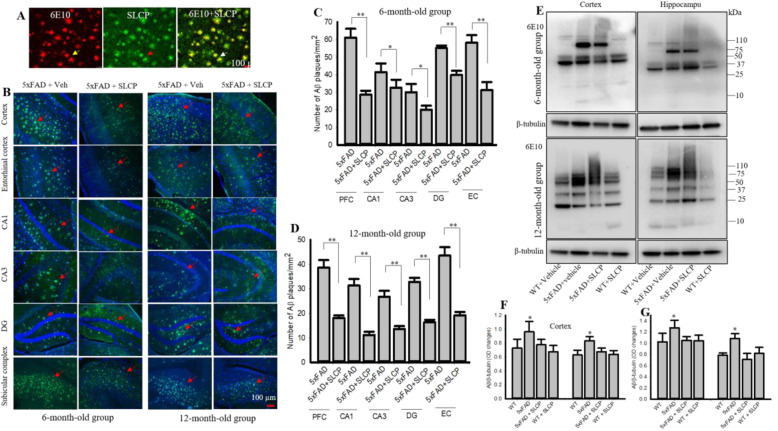Fig. 3.
SLCP inhibited Aβ plaque load and amount of Aβ in 5xFAD brain. Six- and twelve-month-old 5xFAD and age-matched control animals were treated with SLCP (100 mg/kg) or vehicle for 2 months, and their brains were perfused with 4% paraformaldehyde. Forty-micron coronal sections were made using a cryostat and were stained with for Aβ using a curcumin-based solution (1 μM, dissolved 70% methanol, 10 min) and the images were taken using a fluorescent microscope with a × 20 objective (total magnification = × 200). a Representative images show that curcumin binds with Aβ, similar to Aβ-specific antibody (6E10). b Representative images of Aβ plaques stained by curcumin in cortex, hippocampus (CA1, CA3, DG, subicular complex), and entorhinal cortex from vehicle- and SLCP-treated 5xFAD mice at both 6- and 12-months of age. c, d Morphometric analysis showed that Aβ plaques were significantly less (*p < 0.05 and **p < 0.01) in all the abovementioned areas of 5xFAD mice treated with SLCP. e Representative Western blot data for Aβ levels from cortical and hippocampal tissue in WT and 5xFAD mice after treatment with SLCP and probe with 6E10. f, g Densitometric analysis revealed that SLCP treatment significantly decreased Aβ levels in 5xFAD mice treated with SLCP in both cortical and hippocampal tissue in both 6- (f) and 12-month (g) mice. Scale bar = 100 μm and is applicable to all images. *p < 0.05, **p < 0.01 in comparison to WT + vehicle, 5xFAD + SLCP, and WT + SLCP

